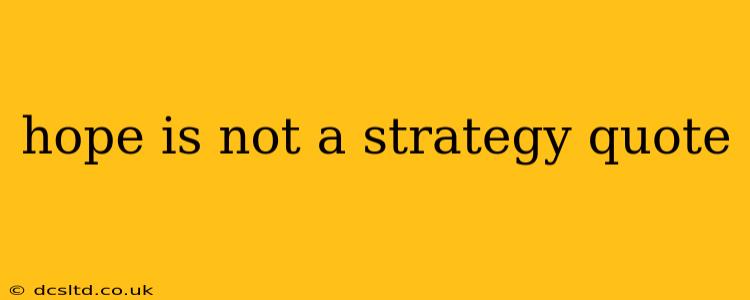The popular adage, "Hope is not a strategy," rings true across all aspects of life, from personal goals to business ventures. While optimism and a positive outlook are essential, relying solely on hope to achieve desired outcomes is a recipe for disappointment. This insightful exploration delves into why a well-defined strategy is paramount for success and how to transition from hopeful wishing to proactive planning.
What Does "Hope Is Not a Strategy" Mean?
This powerful statement highlights the crucial difference between wishful thinking and strategic planning. Hope represents a passive expectation of a favorable outcome, while a strategy involves a proactive, detailed plan with actionable steps designed to achieve specific objectives. Simply hoping for success without a roadmap to get there is ineffective; it's like setting sail without a map or compass.
Why is a Strategy Essential for Success?
A robust strategy provides several critical advantages:
- Clear Direction: A well-defined strategy provides a clear path towards your goals, eliminating confusion and uncertainty. It outlines the specific steps needed, ensuring you're always moving forward.
- Resource Allocation: Strategies guide the effective allocation of resources – time, money, energy, and people – maximizing their impact and minimizing wasted effort.
- Risk Mitigation: A comprehensive strategy anticipates potential challenges and obstacles, allowing you to develop contingency plans and minimize risks.
- Measurable Progress: Strategies incorporate metrics and milestones, enabling you to track progress, identify areas for improvement, and make necessary adjustments along the way.
- Increased Confidence: Having a clear plan instills confidence and reduces anxiety. Knowing you have a structured approach to achieve your goals empowers you to take action.
What are the Components of a Successful Strategy?
A successful strategy isn't just a wish list; it's a meticulously crafted plan. Key components include:
- Clearly Defined Goals: What are you trying to achieve? Your goals should be specific, measurable, achievable, relevant, and time-bound (SMART).
- Target Audience/Market Analysis: Who are you trying to reach? Understanding your audience is crucial for tailoring your approach.
- Competitive Analysis: Who are your competitors? Understanding their strengths and weaknesses allows you to differentiate yourself.
- Actionable Steps: Break down your goals into manageable, actionable steps. What specific actions will you take to achieve each step?
- Timeline and Milestones: Establish a realistic timeline with key milestones to track progress.
- Metrics and Measurement: How will you measure success? Define key performance indicators (KPIs) to track your progress.
- Contingency Planning: What are the potential obstacles? Develop contingency plans to address unexpected challenges.
How Can I Move from Hope to Strategy?
Shifting from hope to strategy requires a conscious and proactive approach:
- Define Your Goals: Clearly articulate what you want to achieve.
- Conduct Research: Gather information, analyze data, and understand the landscape.
- Develop a Plan: Outline the steps needed to reach your goals.
- Take Action: Start implementing your plan.
- Monitor and Adjust: Track your progress, make adjustments as needed, and remain adaptable.
What are the Consequences of Relying on Hope Alone?
Relying solely on hope can lead to:
- Missed Opportunities: Without a strategy, you might miss crucial opportunities that could propel your success.
- Wasted Resources: You might expend significant time, energy, and resources without seeing tangible results.
- Frustration and Disappointment: The lack of progress can lead to feelings of frustration and disappointment.
- Procrastination: The lack of a clear plan can lead to procrastination and inaction.
How Do I Create a Strategy? (A Step-by-Step Guide)
Creating a winning strategy is a process. Start with these steps:
- Set SMART goals: Specific, Measurable, Achievable, Relevant, and Time-bound.
- Conduct thorough research: Understand your market, competition, and target audience.
- Analyze your resources: Identify the time, money, and personnel you have available.
- Outline your action plan: Break down your goals into manageable steps.
- Develop contingency plans: Prepare for potential obstacles.
- Set a timeline and milestones: Establish deadlines and track your progress.
- Regularly review and adjust your strategy: Be flexible and adaptable to changing circumstances.
In conclusion, while hope can be a powerful motivator, it's not a substitute for a well-defined strategy. By embracing proactive planning and developing a clear roadmap, you significantly increase your chances of achieving your goals and transforming your hopes into tangible realities. Remember, success isn't just about wishing; it's about planning, executing, and adapting.
